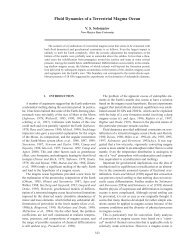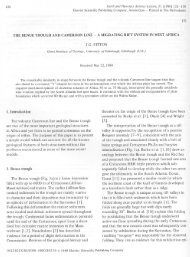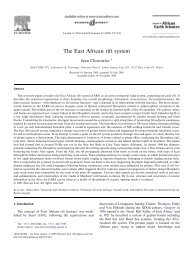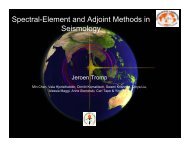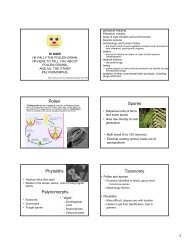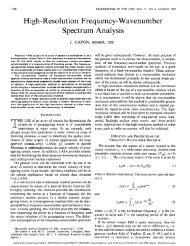Directional Recording of Swell from Distant Storms - Department of ...
Directional Recording of Swell from Distant Storms - Department of ...
Directional Recording of Swell from Distant Storms - Department of ...
Create successful ePaper yourself
Turn your PDF publications into a flip-book with our unique Google optimized e-Paper software.
560 W. H. MUNK, G. R. MILLER, F. E. SNODGRASS AND N. F. BARBERWe suggest that the three observed features, the narrowness <strong>of</strong> the ridge, the directionalgradient, and the speed <strong>of</strong> the storm are related. For an approaching storm one frequency isamplified over all others: the frequency whose group velocity equals the rate at which thestorm approaches. The amplification is particularly pronounced if the storm approaches ata constant rate. The existence <strong>of</strong> such a 'group velocity peak' has been noted by Eckart(I953) for waves generated by a moving gust, and is implicit in his equation (35). Munk &Snodgrass (I957) have discussed this effect as applied to a source moving at constant speedalong some fixed latitude.ftl t2 tl t2FIGURE 37. Thef-t diagram for a stationary source (right) and a source approaching thestation with a speed (A1-A2)/(t2 - tl) (left).00AFIGURE 38. Variations in the recorded wave direction and distance resulting<strong>from</strong> a movement <strong>of</strong> the source with a speed U in a direction q.Consider a storm generating waves in a time interval t1 to t2 (figure 37). If it remained ata fixed distance, A1, <strong>from</strong> the wave station (but not necessarily in a fixed direction), then therecorded duration is t2 to t1 and the directional gradient is independent <strong>of</strong> frequency. Butif the storm approaches the station at some velocity, U, then the waves are 'focused' at thatparticular frequencyf for which V(f) = U.Near the focus waves <strong>from</strong> different directions have nearly the same frequency, andaccordingly 6O/Sf is very large. Consider a source moving at a velocity U in a direction Srelative to the line <strong>of</strong> sight (figure 38). Then in a time At, the direction and distance <strong>of</strong> thesource vary by an amountasCB U&tsinqX &A =ACzzU&tcos03




